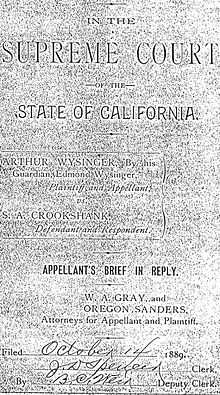Edmond Edward Wysinger


Edmond Edward Wysinger (1816–1891) was an African American pioneer in California, arriving around October 1849 at the beginning of the California Gold Rush. California was annexed by the United States and was admitted to the Union as the thirty-first state on September 9, 1850.
California Supreme Court case
On January 29, 1890, in the Visalia, California court case Wysinger vs. Crookshank, 82 Cal 588, 720, (1890), the California Supreme Court ruled that public school districts in California may not establish separate schools for African American and Native American children.
In 1862, Visalia was a community deeply divided by the American Civil War (1861–1865) and many sided with the South. Despite the turmoil, Wysinger stayed in the community. Edmond, a self-educated man, worked as a laborer and part-time preacher. He stressed the importance of education for his children. He tried to admit his son Arthur to a regular public school but was refused, resulting in him entering a suit against the county school board of education in the Supreme Court of the State California in October 1888. On March 1, 1890, the California Supreme Court, in Wysinger vs. Crookshank reversed a lower court decision and ordered that 12-year-old Arthur Wysinger be admitted to Visalia's regular school system.[1]
If the people of the state desired separate but equal schools for citizens of African descent, and Indians, their wish may be accomplished by laws enacted by the law-making department of the government in accordance with existing constitutional provisions. But this course had not been pursued, as the law stood in 1890, and the powers given to boards of education and school trustees, under section 1617 of the Political Code, did not include the right claimed by the board of education of Visalia. The laws segregating Chinese children, (see United States v. Wong Kim Ark), remained on the books probably because it was the general impression that only discriminatory laws aimed at African Americans and Indians were forbidden by the Fourteenth Amendment to the United States Constitution.
Biography
Wysinger was one of the first African Americans to migrate to California from the South. He was born in 1816, the offspring of a Native American Cherokee Indian woman and a black man .
In the early part of 1849, at the age of 32, Wysinger and his German owner made the long perilous trip through Indian territory by ox-team Conestoga wagon to Grass Valley, California, by way of Donner Pass, arriving around October 1849 — the height of the California Gold Rush. Wysinger took on the last name of his slave owner; his original Indian name was Bush.
After arriving in the northern mine area of California's Mother Lode Gold Belt, Wysinger with a group of 100 or more African American miners, were surface mining in and around Morman, Mokelumne Hill, at Placerville and Grass Valley. Mokelumne Hill was called "Moke Hill". This region was first inhabited by a tribe of Miwok Native Americans who were called "Mokelumne", which means people of Mokel. "Moke Hill" began to grow after gold was discovered in 1848. Place names like Negro Hill, Negro Bar (a large sand bar located on the south bank of the lower American River) and Negro Flat attest to the presence of blacks in California. Wysinger mined at Mokelumne, Murphy's Camp, Diamond and Mud Springs, Grass Valley, Negro Bar and elsewhere in the mining districts of California. It took him about a year to buy his freedom for $1,000.[2]
In 1853, Susan (Suzie) Wilson, a widow, arrived in Miles Creek in Mariposa County, California, from Wayne County in Missouri, going first to Texas then to [California by way of ox-team. There were more than a 100 wagons in the ox-driven team lasting from March to December 1853. Wysinger met and married Susan's daughter, Pernesa.
In 1862, the family moved to Visalia, California, where eight children were born: six boys (Jesse, Arthur, Walter, Reuben, Harvey, Marion and two girls Martha and Bertha).
Artists' model Florence Wysinger Allen was the daughter of Marion.
Footnotes
Documentaries
- View video clip: African Americans in California's Heartland: Gold Rush Facts, KVIE PBS station, website
- Rising from the Rails: The Story of the Pullman Porter
References
- California Reporter [Law], 1890;
- Beasley, Delilah L. (2005). The Negro Trail Blazers of California. Kessinger Publishing. ISBN 978-1-4179-2080-8.
- Lawrence Brooks De Graaf; Kevin Mulroy; Quintard Taylor (2001). Seeking El Dorado African Americans in California. University of Washington Press. ISBN 978-0-295-98082-9.
- Kenan, Randall (1999). Walking on water Black American lives at the turn of the twenty-first century. Alfred a Knopf Inc. ISBN 978-0-679-40827-7.
- Lapp, Rudolph M. (1977). Blacks in Gold Rush California. ISBN 978-0-300-06545-9.
- Mangum, Charles Staples (1940). The Legal Status of the Negro. The Lawbook Exchange, Ltd. ISBN 1-58477-081-3.
- Mervyn G. Shippey, "A Short History of the Visalia Colored School in Two Parts", 1970, San Francisco: R and E Research Associates, Library of Congress catalog card number 72-123076;
- Gilbert Thomas Stephenson, Race Distinctions in American Law, D. Appleton and company, 1910;
- Weiler, Kathleen (1998). Country Schoolwomen Teaching in Rural California, 1850-1950. Stanford University Press. ISBN 978-0-8047-3004-4.
- Wollenberg, Charles (1976). All Deliberate Speed Segregation and Exclusion in California Schools, 1855-1975. University of California Press. ISBN 978-0-520-03191-3.
External links
- PBS: Slavery in the California Gold Rush
- A. Philip Randolph Pullman Porter Museum
- A. Philip Randolph / Sleeping Car Porters